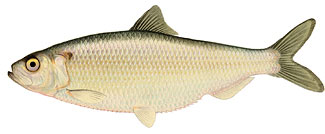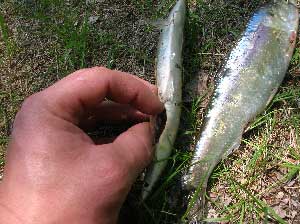Blueback Herring
Alosa aestivalis
 Distribution: Blueback herring migrate from the ocean into Atlantic coastal rivers from Nova Scotia to Florida. In New Hampshire, blueback herring historically spawned in the the Merrimack River,and the Connecticut River, along with the rivers and streams that drain into the Great Bay estuary and the seacoast.
Distribution: Blueback herring migrate from the ocean into Atlantic coastal rivers from Nova Scotia to Florida. In New Hampshire, blueback herring historically spawned in the the Merrimack River,and the Connecticut River, along with the rivers and streams that drain into the Great Bay estuary and the seacoast.
Description: The blueback herring may grow up to 15 inches, but is generally smaller than the alewife. It has a bluish-green dorsal color, large silvery scales, and a deeply forked tail. The blueback herring may be distinguished from the alewife by its smaller eye. The width of its eye is the same length as the distance from the tip of the snout to the front edge of the eye. The inner lining of the blue back herring’s body cavity, called the peritoneum, is black, as opposed to the white lining of the alewife. The lower jaw of the alewife has an indented, or shovel shaped appearance, while the American shad has a straight lower jaw.
Species commonly confused with: Alewife, juvenile American shad
Habitat:Blueback herring inhabit coastal waters for most of their lives, but they migrate into freshwater rivers and streams to spawn. Unlike alewives, which spawn in the calm water of lakes, ponds, and backwaters of rivers, blueback herring prefer to spawn in flowing water.
Life History: The life history of the blueback herring is similar to that of the closely related alewife. Both species are anadromous, which means that they live in the ocean, but migrate into freshwater habitats to spawn. The blueback herring has a more southern distribution than the alewife and prefers to spawn in slightly warmer water. In New Hampshire, the spawning run of blueback herring usually begins in late May and peaks in June. Eggs are deposited in areas of moderate current in rivers and streams. Juvenile blueback herring grow rapidly in freshwater until late summer and fall, when they migrate downstream to the ocean. Maturity is reached after 3 to 4 years in males and 4 to 5 years in females. Blueback herring may live up to 8 years and can spawn multiple times. Juveniles feed on zooplankton, while the diet of adults consists of small fish and plankton. Adults do not feed during their spawning run. Little is known about the habits of blueback herring in salt water.
Origin: Native
Conservation/Management: Blueback herring numbers have declined throughout their range. Commercial landings of river herring, a collective term for alewives and blueback herring, have declined by 95% since 1950. These declines have been observed in local rivers, such as the Oyster River in Durham and the Taylor River in Hampton. Twenty years ago, these rivers supported productive blueback herring runs with counts exceeding 100,000. Currently, only a few thousand blueback herring are counted at the Oyster River each spring and the Taylor River blueback herring run has been reduced to less than 100 fish.
The NHFGD is working to restore river herring to coastal rivers and the Merrimack River watershed. Fish ladders are monitored at the first dams on the major tributaries of Great Bay, including the Cocheco, Oyster, and Lamprey Rivers. However, much of the former spawning habitat of river herring remains inaccessible in New Hampshire.

Dam removals are the best long term strategy for restoring river herring runs. The removal of the Great Dam in Exeter improved access for river herring to over 7 miles of potential spawning habitat in the lower Exeter River. In May, fish can be seen swimming up the ledges where the old dam once stood as they run a gauntlet of sea gulls, cormorants, and other predators.
Fish passage construction is the best option for restoring river herring populations to rivers where dams are unlikely to be removed. However, blueback herring may be reluctant to use certain fishways compared to alewives. Blueback herring are rarely observed using the fish lift at the Essex Dam on the Merrimack River. New Hampshire Fish and Game biologists work closely with U. S. Fish and Wildlife Service fish passage engineers to recommend fish passage designs that will be effective for multiple species.
The river herring population in the Merrimack River watershed has been severely depleted. Historic spawning runs, which likely numbered in the millions, had been reduced to the low thousands by the year 2010. The New Hampshire Fish and Game Department is working with partners like the U. S. Fish and Wildlife Service and the Massachusetts Fish and Wildlife Division to restore river herring numbers in the Merrimack River. Strategies include stocking adult river herring into suitable habitat within the Merrimack River watershed. Initially these fish were transferred from other rivers including the Kennebec, Androscoggin, Lamprey, and Cocheco Rivers. As runs began to increase in 2015, more fish were stocked from the Merrimack River. Fish are collected from fishways at dams and loaded onto stocking trucks. The largest of the stocking sites is Lake Winnisquam, which has the potential to produce millions of juvenile river herring each year. In 2018, the number of river herring counted at the Essex Dam on the Merrimack River in Lawrence, MA set a new record of 449,356 fish.
The ultimate success of the restoration program will depend on improvements in fish passage, which will allow river herring to reach as much suitable spawning habitat as possible. Fish passage is currently available at the first three dams on the mainstem of the Merrimack River (the Essex Dam in Lawrence, MA, the Pawtucket Dam in Lowell, MA, and the Amoskeag Dam in Manchester, NH) and at the first two dams on the Nashua River. The long term goal of a self-sustaining river herring population in the Merrimack River will depend largely on the efficiency of these existing fishways and on the construction of new fishways at dams throughout the Merrimack River watershed.



